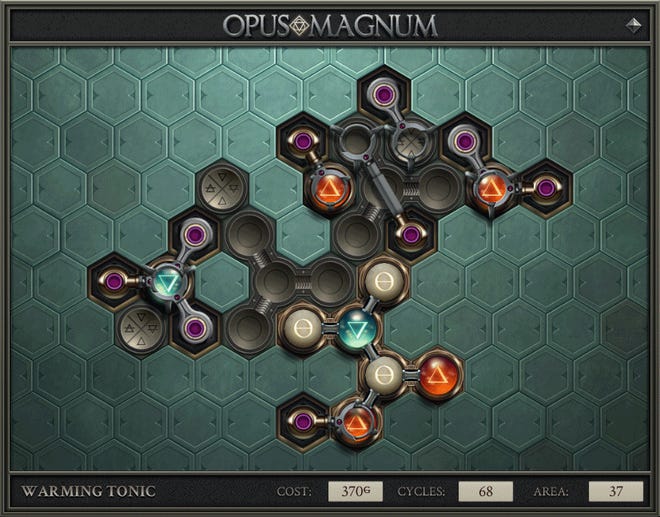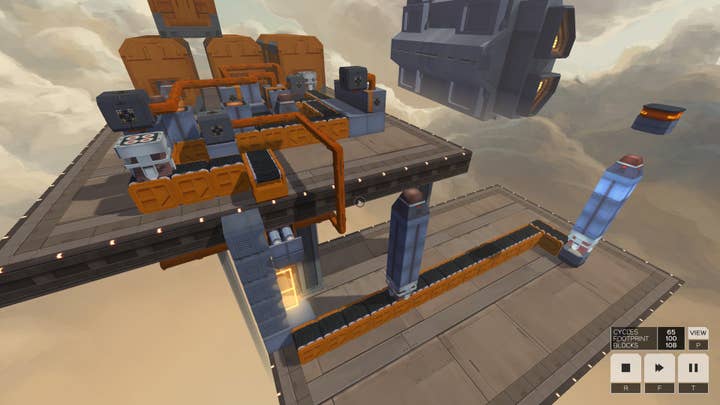How Zachtronics makes its games so GIFable
Studio founder Zach Barth discusses the beauty of seamless loops, and why screenshots are more important for indies than trailers
It's likely that your first encounter with Opus Magnum was something like the image below.
The alchemical puzzler has something of a viral quality with fans sharing their solutions to each of its puzzles via social media and forums in the form of GIFs.
In just one looping image, you instantly get a sense of what the game is about: creating machines that automatically assemble different components together into the required structure.
Opus Magnum is one of many games from developer Zachtronics rooted in scientific subjects, with a view to exploring subjects like chemistry, industry and (in this case) programming. In fact, all of its titles have now been made free to educators.

GamesIndustry.biz spoke to founder Zach Barth earlier this year about the art of making such complex puzzle games instantly understandable, aided by the use of GIFs. Was it a goal of the studio to develop a title that was inherently GIFable?
"No, that would be terrible," Barth laughs. "Can you imagine being that kind of game designer?"
"We built it into Opus Magnum from the beginning. Before the game even had graphics, it had GIFs"
Instead, Opus Magnum -- actually the second Zachtronics title to include a GIF feature -- is built upon learnings from past games. For its origins, we need to go back to The Codex of Alchemical Engineering, a Flash game Barth and his colleagues developed before the studio had even formed -- "the first hardcore Zach-like, if we can call it that," he says.
Like Opus Magnum, this revolved around building a machine that took elements and combined them together. Initially only available through Barth's website, players encouraged him to publish Codex through Kongregate, suggesting he might make more money that way.
"I didn't want to make money making indie games," he recalls. "Some people were making money, but I was like, 'No, I don't care about that, I'm making these for fun, for myself.' Which is weird now and sounds crazy even coming out of my mouth, because I'm all about the money now apparently. "
It was the Kongregate community that sowed the seed for the GIF function. The Codex of Alchemical Engineering saved players' progress but not their specific solutions -- however you could export the text instructions for that machine to be shared elsewhere (to this day, Barth is still not sure why he coded the game this way).
Players would then share their text on the forums, bragging about how few cycles they had been able to complete each puzzle in. Fellow fans would then look at their solutions and find ways to improve it, again sharing the text.
"I'd never intended that to be a thing," says Barth. "That was something we accidentally discovered through player behaviour."

When he and his team moved on to SpaceChem, a spiritual successor, they knew they needed to find a way to let players show off their creations. The answer? Videos that could be uploaded to YouTube "because it was 2011 and that was the thing." A video encoder was painstakingly developed and, sure enough, SpaceChem clips began appearing on the growing platform.
"That was the game that made us into a real games studio," says Barth. "It was just me and some other people making games on the side, but we were like, 'Okay, we've made some money, we can actually make a games studio.' We wanted to make a game that would be better than SpaceChem, more accessible, look better, and we thought we we're going to sell twice as many copies. And it didn't -- it was way worse and sold way fewer copies."
The team instead fell back on the SpaceChem formula and tried to build another title that centred around puzzles with looping solutions, a project that became Infinifactory. This involved building 3D factories that constantly produced products for alien overlords, and once again YouTube was high on Zachtronics' priority list.
Barth and his team spent a long time improving on the video encoder, trying to find a way to make the created factories look fun and convey the premise of the game, but dissatisfied with the results, they opted not to ship this functionality.
But during the game's early access period, one of its more devoted players made an animated GIF of one of their solutions. They had recorded a few frames of their factory from afar, spliced it together to make a looping GIF and uploaded it to the Steam forums. It was a eureka moment for Barth.
"When people look at the Steam page, they're probably not going to watch the trailer. But that screenshot better fucking sell the game right away"
"I looked at it and five seconds later, I was like, 'Oh yeah, we need to make the game export these so that everyone who's not this person can make theirs just like that.' Just seeing that you could do that was all I needed.
"I took all the code I'd written for the YouTube thing that we'd never shipped, I stopped doing everything else and just did this for two days, and we shipped this feature where you could record GIFs. And it didn't blow up or anything, but all the people in the community were like, 'Oh, this is awesome.'"
SpaceChem and Infinifactory both share one aspect that makes them inherently GIFable: they revolve around building something that loops seamlessly. Barth stresses that neither title were designed this way specifically to cater for GIFs, but rather than this "obscure file format" just happens to perfectly capture the heart of each game.
And Zachtronics has by no means specialised in games that lend themselves to GIFs. Neither TIS-100 nor Shenzhen I/O have gameplay that is appropriate, so neither have a GIF export. Even Exapunks, a title Barth didn't believe to be GIFable at first, only added the function after the fact.
When it came to developing Opus Magnum, however, GIFs were a priority from the start.
"Immediately, we knew this would have that same seamless looping property so from the get go we knew we would do GIFs," says Barth. "We built it in from the beginning. Before the game even had graphics, it had GIFs -- they were just these black outlines with symbols in them."

Building on the export function developed for Infinifactory, Zachtronics improved the output to make Opus Magnum's GIFs branded, giving them a nice frame, in that hopes that when shared online they would "pull themselves out of the flatness of the page" and help raise the game's exposure. And unlike Exapunks, which only had a handful of levels that could be appropriately expressed in GIF form, every puzzle in Opus Magnum works as a looping image.
"It's probably part of why that game blew up," says Barth. "The game was a hit from the get-go, and the GIFs are a part of that, but it's also the most accessible Zachtronics game, it's not about programming, and it doesn't have a manual you have to read. Of the four games we've done most recently, three of them are programming games that require you to read a manual. It's the only accessible game in that whole lot.
"Infinifactory didn't do pretty great too from a sales perspective, although that wasn't necessarily to do with the GIFs. I think the properties that make these games GIFable is the thing that makes them pretty good -- they've very spatial, very visual and have that satisfying looping thing."
That said, Barth stresses that GIFs aren't the starting point for any of Zachtronics' project -- "We're not a GIF studio" -- and while other indies have previously said these images can be essential in conveying the core loops of their gameplay, Barth believes static screenshots are more important.
"Most people talk about trailers, and how the first five seconds of the trailer has to grab you," he observes. "I don't even watch trailers, because I'm so trained to thinking that they're going to be filled with bullshit. They're just going to be cinematic, they're not going to be the game.
"A screenshot is way more likely to show you the game, the UI and stuff like that. I was talking to some other indie devs who say they like to show the UI, because that shows all the affordances, which shows what you're going to be doing. These are the buttons you're going to click, these are the actions you're going to take and the decisions you're going to make -- not some cinematic thing that doesn't tell you anything about the game. That's something AAA people can do because they get away with that, apparently. But as an indie, you can't do that."
He concludes: "When people look at the Steam page, they're probably not going to watch the trailer right away. The first thing they're going to see is a tiny little preview of a screenshot and if that looks intriguing, maybe they'll click that and that screenshot better fucking sell the game right away. Because somebody's going to take one look at it and decide whether or not they want to buy the game, or maybe watch the trailer first. I don't have the data for that, but I know that I, for one, hate video game trailers and they don't ever explain everything."

